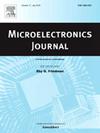A 107.5-dB dynamic range 402-μW event-driven dynamic zoom ADC with voice activity detection function for audio applications
IF 1.9
3区 工程技术
Q3 ENGINEERING, ELECTRICAL & ELECTRONIC
引用次数: 0
Abstract
This paper presents a dynamic zoom analog-to-digital converter (ADC) for audio applications, which combines a 5-bit coarse event-driven (ED) ADC (also called level-crossing ADC) and a 3rd-order, single-bit discrete-time ΔΣ modulator (ΔΣM). With 2 low-power continuous-time (CT) comparators and a corresponding digital circuit operating only at the event that the input signal crosses the reference levels, the coarse ED ADC consumes much less power than those coarse SAR ADCs operating under the sampling frequency (Fs) in the conventional dynamic zoom ADC schemes, because the ED scheme operates with much less activity and shows higher adaptivity to real acoustic signal applications. Moreover, the ED ADC output can be utilized to generate a voice activity detection (VAD) signal, which provides a simple on-device audio computing function for the analog front-ends in audio applications. A cascoded floating-inverter-amplifier (FIA) based integrator is employed in the fine ΔΣM to reduce power consumption further. Fabricated in a 0.18-μm CMOS process, the prototype ADC chip achieves 102.1-dB peak signal-to-noise ratio (SNR), 103.1-dB peak signal-to-noise-and-distortion ratio (SNDR), and 107.5-dB dynamic range (DR) for a 24-kHz bandwidth and 6.144-MHz Fs, while consuming only 402 μW under the 1.8-V power supply, resulting in a Schreier Figure-of-Merit (FoMs) of 185.3 dB.
107.5 db动态范围402 μ w事件驱动动态变焦ADC,具有语音活动检测功能,适用于音频应用
本文介绍了一种用于音频应用的动态变焦模数转换器(ADC),它结合了一个5位粗事件驱动(ED) ADC(也称为平交ADC)和一个三阶单比特离散时间ΔΣ调制器(ΔΣM)。粗ED ADC采用2个低功耗连续时间(CT)比较器和一个相应的数字电路,仅在输入信号超过参考电平时工作,与传统动态变焦ADC方案中在采样频率(Fs)下工作的粗SAR ADC相比,粗ED ADC消耗的功率要小得多,因为ED方案的工作活性要小得多,并且对实际声学信号应用具有更高的自适应能力。此外,ED ADC输出可用于生成语音活动检测(VAD)信号,为音频应用中的模拟前端提供简单的设备上音频计算功能。为了进一步降低功耗,在ΔΣM中采用了基于级联编码浮点逆变放大器(FIA)的积分器。该原型ADC芯片采用0.18 μm CMOS工艺制作,在24 khz带宽和6.144 mhz频域下,峰值信噪比(SNR)为102.1 dB,峰值信噪比(SNDR)为103.1 dB,动态范围(DR)为107.5 dB,功耗仅为402 μW,在1.8 v电源下,Schreier品质图(FoMs)为185.3 dB。
本文章由计算机程序翻译,如有差异,请以英文原文为准。
求助全文
约1分钟内获得全文
求助全文
来源期刊

Microelectronics Journal
工程技术-工程:电子与电气
CiteScore
4.00
自引率
27.30%
发文量
222
审稿时长
43 days
期刊介绍:
Published since 1969, the Microelectronics Journal is an international forum for the dissemination of research and applications of microelectronic systems, circuits, and emerging technologies. Papers published in the Microelectronics Journal have undergone peer review to ensure originality, relevance, and timeliness. The journal thus provides a worldwide, regular, and comprehensive update on microelectronic circuits and systems.
The Microelectronics Journal invites papers describing significant research and applications in all of the areas listed below. Comprehensive review/survey papers covering recent developments will also be considered. The Microelectronics Journal covers circuits and systems. This topic includes but is not limited to: Analog, digital, mixed, and RF circuits and related design methodologies; Logic, architectural, and system level synthesis; Testing, design for testability, built-in self-test; Area, power, and thermal analysis and design; Mixed-domain simulation and design; Embedded systems; Non-von Neumann computing and related technologies and circuits; Design and test of high complexity systems integration; SoC, NoC, SIP, and NIP design and test; 3-D integration design and analysis; Emerging device technologies and circuits, such as FinFETs, SETs, spintronics, SFQ, MTJ, etc.
Application aspects such as signal and image processing including circuits for cryptography, sensors, and actuators including sensor networks, reliability and quality issues, and economic models are also welcome.
 求助内容:
求助内容: 应助结果提醒方式:
应助结果提醒方式:


